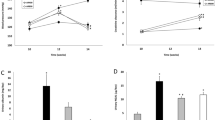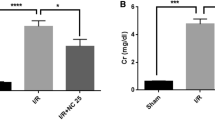Abstract
Purpose
The pathogenic mechanisms leading to cardiovascular disorders in patients with chronic kidney disease have not been clearly established, although increased oxidative stress has been pointed out as a potential cause. Therefore, as cardiovascular events are still the first cause of death in patients with chronic kidney disease and traditional drugs or therapies rarely have effects on cardiac complications, we sought to determine the effect of curcumin in treating cardiac dysfunction in rats with established chronic renal disease.
Methods and Results
Treatment consisted in daily administration of curcumin (120 mg/kg/day) dissolved in 0.05 % carboxymethylcellulose via oral gavages during 30 days, beginning from day 30 after 5/6 nephrectomy (5/6Nx). Cardiac function, markers of oxidative stress, activation of PI3K/Akt/GSK3β and MEK1/2-ERK1/2 pathway, metalloproteinase-II (MMP-2) content, overall gelatinolytic activity, ROS production and mitochondrial integrity were evaluated after 1-month treatment. Curcumin restored systolic blood pressure, diminished interventricular and rear wall thickening, decreased left ventricle dimension at end-systole (LVSd) and restored ejection fraction in nephrectomized rats. Also, it diminished metalloproteinase-II levels and overall gelatinase activity, decreased oxidative stress and inhibited the mitochondrial permeability transition pore opening.
Conclusion
Our findings suggest that curcumin might have therapeutic potential in treatment of heart disease in patients with established CKD by attenuating oxidative stress-related events as cardiac remodeling, mitochondrial dysfunction and cell death.






Similar content being viewed by others
References
Clark LE, Khan I. Outcomes in CKD: what we know and what we need to know. Nephron Clin Pract. 2010;114:c95–c102.
National Kidney Foundation. K/DOQI clinical practice guidelines for chronic kidney disease: evaluation, classification, and stratification. Am J Kidney Dis. 2002;39:S1–S266.
Chronic Kidney Disease Prognosis Consortium, Matsushita K, van der Velde M, et al. Association of estimated glomerular filtration rate and albuminuria with all-cause and cardiovascular mortality in general population cohorts: a collaborative meta-analysis. Lancet. 2010;375:2073–81.
Van Biesen W, De Bacquer D, Verbeke F, Delanghe J, Lameire N, Vanholder R. The glomerular filtration rate in an apparently healthy population and its relation with cardiovascular mortality during 10 years. Eur Heart J. 2007;28:478–83.
Brown JR, Cochran RP, Leavitt BJ, et al. Multivariable prediction of renal insufficiency developing after cardiac surgery. Circulation. 2007;116:I139–43.
Hillege HL, Nitsch D, Pfeffer MA, et al. Renal function as a predictor of outcome in a broad spectrum of patients with heart failure. Circulation. 2006;113:671–8.
Zhang K, Wang J, Zhang H, et al. Mechanisms of epoxyeicosatrienoic acids to improve cardiac remodeling in chronic renal failure disease. Eur J Pharmacol. 2013;701:33–9.
Correa F, Buelna-Chontal M, Hernández-Reséndiz S, et al. Curcumin maintains cardiac and mitochondrial function in chronic kidney disease. Free Radic Biol Med. 2013;61C:119–29.
Gupta SC, Prasad S, Kim JH, et al. Multitargeting by curcumin as revealed by molecular interaction studies. Nat Prod Rep. 2011;28:1937–55.
Ghosh SS, Massey HD, Krieg R, et al. Curcumin ameliorates renal failure in 5/6 nephrectomized rats: role of inflammation. Am J Physiol Renal Physiol. 2009;296:F1146–57.
Sharma S, Kulkarni SK, Chopra K. Curcumin, the active principle of turmeric (Curcuma longa), ameliorates diabetic nephropathy in rats. Clin Exp Pharmacol Physiol. 2006;33:940–5.
Negi PS, Jayaprakasha GK, Jagan ML, Sakariah KK. Antibacterial activity of turmeric oil: a byproduct from curcumin manufacture. J Agric Food Chem. 1999;47:4297–300.
Trujillo J, Chirino YI, Molina-Jijón E, Andérica-Romero C, Tapia E, Pedraza-Chaverri J. Renoprotective effect of the antioxidant curcumin: recent findings. Redox Biol. 2013;1:448–56.
Molina-Jijón E, Tapia E, Zazueta C, et al. Curcumin prevents Cr(VI)-induced renal oxidant damage by a mitochondrial pathway. Free Rad Biol Med. 2011;51:1543–57.
González-Salazar A, Molina-Jijón E, Correa F, et al. Curcumin protects from cardiac reperfusion damage by attenuation of oxidant stress and mitochondrial dysfunction. Cardiovasc Toxicol. 2011;11:357–64.
Reddy A, Lokesh BR. Studies on the inhibitory effects of curcumin and eugenol on the formation of reactive oxygen species and the oxidation of ferrous iron. Mol Cell Biochem. 1994;137:1–8.
Sreejayan N, Rao MN. Nitric oxide scavenging by curcuminoids. J Pharm Pharmacol. 1997;49:105–7.
Tapia E, Soto V, Ortiz-Vega KM, et al. Curcumin induces Nrf2 nuclear translocation and prevents glomerular hypertension, hyperfiltration, oxidant stress and the decrease in antioxidant enzymes in 5/6 nephrectomized rats. Oxid Med Cell Longev. 2012;2012:269039.
Balogun E, Hoque M, Gong P, et al. Curcumin activates the haem oxygenase-1 gene via regulation of Nrf2 and the antioxidant-responsive element. Biochem J. 2003;371:887–95.
Ghosh SS, Salloum FN, Abbate A, et al. Curcumin prevents cardiac remodeling secondary to chronic renal failure through deactivation of hypertrophic signaling in rats. Am J Physiol Heart Circ Physiol. 2010;299:H975–84.
Izem-Meziane M, Djerdjouri B, Rimbaud S, et al. Catecholamine-induced cardiac mitochondrial dysfunction and mPTP opening: protective effect of curcumin. Am J Physiol Heart Circ Physiol. 2012;302:H665–74.
Hernández-Reséndiz S, Roldán FJ, Correa F, et al. Postconditioning protects against reperfusion injury in hypertensive dilated cardiomyopathy by activating MEK/ERK1/2 signaling. J Card Fail. 2013;19:135–46.
Wandt B, Bojo L, Tolagen K, Wranne B. Echocardiographic assessment of ejection fraction in left ventricular hypertrophy. Heart. 1999;82:192–8.
Martínez-Abundis E, Correa F, Pavón N, Zazueta C. Bax distribution into mitochondrial detergent-resistant microdomains is related to ceramide and cholesterol content in postischemic hearts. FEBS J. 2009;276:5579–88.
Rottenberg H. Membrane potential and surface potential in mitochondria: uptake and binding of lipophilic cations. J Membr Biol. 1984;81:127–38.
Bae IH, Park MJ, Yoon SH, et al. Bcl-w promotes gastric cancer cell invasion by inducing matrix metalloproteinase-2 expression via phosphoinositide 3-kinase, Akt, and Sp1. Cancer Res. 2006;66:4991–5.
Kurata H, Thant AA, Matsuo S, et al. Constitutive activation of MAP kinase kinase (MEK1) is critical and sufficient for the activation of MMP-2. Exp Cell Res. 2000;254:180–8.
Dedkova EN, Seidlmayer LK, Blatter LA. Mitochondria-mediated cardioprotection by trimetazidine in rabbit heart failure. J Mol Cell Cardiol. 2013;59:41–54.
Correa F, García N, Robles C, Martínez-Abundis E, Zazueta C. Relationship between oxidative stress and mitochondrial function in the post-conditioned heart. J Bioenerg Biomembr. 2008;40:599–606.
Wanner C. Disease in Chronic Kidney Disease Patients. Semin Nephrol. 2009;29:24–29.
Jamison RL, Hartigan P, Kaufman JS, et al. Effect of homocysteine lowering on mortality and vascular disease in advanced chronic kidney disease and end-stage renal disease: a randomized controlled trial. JAMA. 2007;298:1163–70.
Tepel M, van der Giet M, Statz M, Jankowski J, Zidek W. The antioxidant acetylcysteine reduces cardiovascular events in patients with end-stage renal failure: a randomized, controlled trial. Circulation. 2003;107:992–5.
Tapia E, Zatarain-Barrón ZL, Hernández-Pando R, et al. Curcumin reverses glomerular hemodynamic alterations and oxidant stress in 5/6 nephrectomized rats. Phytomedicine 2013;20:359–66.
Kuo JJ, Chang HH, Tsai TH, Lee TY. Positive effect of curcumin on inflammation and mitochondrial dysfunction in obese mice with liver steatosis. Int J Mol Med. 2012;30:673–9.
Yeh CH, Chen TP, Wu YC, Lin YM, Jing LP. Inhibition of NFkappaB activation with curcumin attenuates plasma inflammatory cytokines surge and cardiomyocytic apoptosis following cardiac ischemia/reperfusion. J Surg Res. 2005;125:109–16.
Schiborr C, Schwamm D, Kocher A, Rimbach G, Eckert GP, Frank J. The senescence-accelerated mouse-prone 8 is not a suitable model for the investigation of cardiac inflammation and oxidative stress and their modulation by dietary phytochemicals. Pharmacol Res. 2013;74:113–20.
Heineke J, Molkentin JD. Regulation of cardiac hypertrophy by intracellular signalling pathways. Nat Rev Mol Cell Biol. 2006;7:589–600.
Yeh CC, Malhotra D, Yang YL, et al. MEK1-induced physiological hypertrophy inhibits chronic post-myocardial infarction remodeling in mice. J Cell Biochem. 2013;114:47–55.
Haq S, Choukroun G, Lim H, et al. Differential activation of signal transduction pathways in human hearts with hypertrophy versus advanced heart failure. Circulation. 2001;103:670–7.
Peterson JT, Hallak H, Johnson L, Li H, O’Brien PM, Sliskovic DR. Matrix metalloproteinase inhibition attenuates left ventricular remodeling and dysfunction in a rat model of progressive heart failure. Circulation. 2001;103:2303–9.
Morimoto T, Sunagawa YK, Awamura T, et al. The dietary compound curcumin inhibits p300 histone acetyltransferase activity and prevents heart failure in rats. J Clin Invest. 2008;118:868–78.
Wang NP, Wang ZF, Tootle S, Philip T, Zhao ZQ. Curcumin promotes cardiac repair and ameliorates cardiac dysfunction following myocardial infarction. Br J Pharmacol. 2012;167:1550–62.
Rahman I, Marwick J, Kirkham P. Redox modulation of chromatin remodeling: impact on histone acetylation and deacetylation, NF-kappaB and pro-inflammatory gene expression. Biochem Pharmacol. 2004;68:1255–67.
Takimoto E, Champion HC, Li M, et al. Oxidant stress from nitric oxide synthase-3 uncoupling stimulates cardiac pathologic remodeling from chronic pressure load. J Clin Invest. 2005;115:1221–31.
Hernández-Reséndiz S, Buelna-Chontal M, Correa F, Zazueta C. Targeting mitochondria for cardiac protection. Curr Drug Targets. 2013;14:586–600.
Abel ED, Doenst T. Mitochondrial adaptations to physiological vs pathological cardiac hypertrophy. Cardiovasc Res. 2011;90:234–42.
Correa F, Soto V, Zazueta C. Mitochondrial permeability transition relevance for apoptotic triggering in the post-ischemic heart. Int J Biochem Cell Biol. 2007;39:787–98.
Gomez L, Li B, Mewton N, et al. Inhibition of mitochondrial permeability transition pore opening: translation to patients. Cardiovasc Res. 2009;83:226–33.
Acknowledgments
This work was partially supported by Grant 177527 to CZ, 167949 to ET, 220046 to JP-Ch and 181593 to FC from CONACYT and, PAPIIT IN210713 to JP-Ch.
Conflict of Interest
The authors declare that they have no conflict of interest.
Author information
Authors and Affiliations
Corresponding author
Additional information
Sauri Hernández-Reséndiz and Francisco Correa contributed equally to this work.
Rights and permissions
About this article
Cite this article
Hernández-Reséndiz, S., Correa, F., García-Niño, W.R. et al. Cardioprotection by Curcumin Post-Treatment in Rats with Established Chronic Kidney Disease. Cardiovasc Drugs Ther 29, 111–120 (2015). https://doi.org/10.1007/s10557-015-6581-x
Published:
Issue Date:
DOI: https://doi.org/10.1007/s10557-015-6581-x




